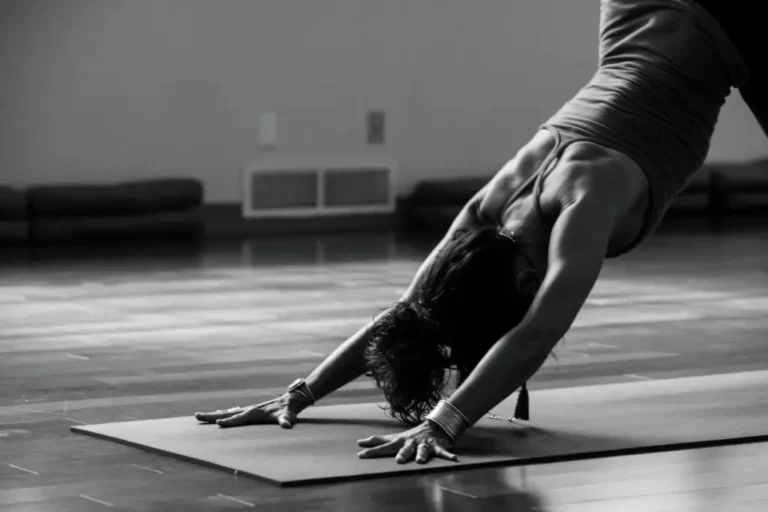Yoga After Eating: The Complete Do’s And Don’ts

For many of us, doing yoga forms part of our workout routine and needs to fit in with busy schedules. While the best option is to do yoga first thing in the morning or on an empty stomach, this is not always possible. Since you likely participate in a yoga class after work, you may wonder if you can do yoga after eating.
Yoga should technically be done on an empty stomach. Many poses involve twists and stances that may leave you feeling sick or uncomfortable if done on a full stomach. If you need to eat before class, opt for a nutritious, light snack with water at least an hour before the start.
While the strict rule is to practice yoga on an empty stomach, and there are good reasons for that, in reality, we may need to eat before class from time to time. Let’s look into the dos and don’ts of eating before yoga and learn what happens if you do yoga after eating.
Can You Do Yoga After Eating?
In a utopian world, we would be practicing yoga in an ashram, surrounded by stunning scenery and led by gurus teaching us the pure way to enlightenment. Sadly, for most of us, our practice is squeezed into (oh, so tight leggings!) an hour a few times a week.
If you are a yogi that needs to attend class after work or as part of a hectic schedule, it may be challenging to comply with the suggestion of practicing on an empty stomach. Whether or not you can stick with the rule or suggestion that yoga should be done on an empty stomach is for your benefit.
What Happens If You Do Yoga After Eating?
There are many reasons to do yoga on an empty stomach. Let us look at the five most likely side effects of doing yoga after eating.
1. Heaviness
When your stomach is full of water or food, it becomes heavier. While doing inverted poses or bends, a heavy stomach can be uncomfortable.
2. Bloatedness
If you practice yoga directly after eating, your stomach is likely still busy processing the food while exercising. Moving in difficult ways and exerting yourself with a full stomach could lead to insufficient digestion and an upset stomach.
Many yogis have reported having to use the bathroom, vomiting, or feeling uncomfortable when practicing too soon after a large meal.
Having a bloated stomach, even if it is not feeling upset, can hinder your performance of certain poses and twists, leading to a less effective yoga session.
3. Weight Retention
If you are on a weight-loss journey, it is best to do yoga on an empty stomach. This rule applies to all types of exercise. Working out on an empty stomach allows your body to use energy stores from your body instead of the food in the stomach.
Energy stores are typically excess fat, so doing yoga on an empty stomach allows your body to use excess fat for fuel rather than that delicious meal you enjoyed before class.
4. Energy Use
When we do yoga on an empty stomach, we allow our bodies and minds to focus solely on the matter at hand, doing the best in our yoga sessions.
Yoga on a full stomach takes energy away from our poses since our bodies are also focused on digesting food. Believe it or not, digesting food uses a fair amount of energy. That is why it is a good idea to rest for a few hours after a large meal.
5. Spiritual Practice
Fasting is often considered a spiritual act. Whether you fast for a few hours or a few days, withholding food for a set time can be beneficial for our spiritual journey. If yoga is part of your spiritual practice, you may find that your session is elevated by a short fast.
Still, yoga is a strenuous activity. If you feel weak or dehydrated, it is best to listen to your body and nourish it before class.
As we can see, the reasons for doing yoga on an empty stomach are sound. From health to spirituality, there are benefits to practicing before eating and not after.
How Can You Do Yoga After Eating?
The question remains, though. Can you do yoga after eating? The short answer is yes!
If you need to eat before practicing yoga, you should follow a few guidelines. If you eat the right food before class, you can still get the most from your session.
The best idea is to listen to your body and your intuition. You know your body the best, so it will serve you well to understand its specific needs on every occasion.
If you feel drained and hungry, it may be best to enjoy a snack a short while before your yoga class. Similarly, it is better to have water before a yoga class than to become dehydrated if you are thirsty.
Suppose you follow strict yoga guidelines. In that case, you may prefer to have water with honey for strength before class. If you are willing to be a little more relaxed, you could enjoy a light snack, preferably raw fruits or vegetables, an hour or two before class.
The best option is to wait at least an hour after eating a light meal or snack. Once your body has had the opportunity to digest the food, your yoga practice will be more beneficial and comfortable.
If you regularly need to snack before yoga class, it is best to have something healthy on hand for sustenance.
Here are our top five snacks to enjoy before a yoga class. Try to eat these at least an hour or two before you begin your yoga session.
1. Raw Fruits And Vegetables
Snacking on raw fruits and vegetables should not hamper your yoga session much. Choose ones you know your body quickly digests to avoid embarrassment during class.
Spinach is an excellent option since it is also loaded with iron. Bananas are a fantastic source of magnesium and give a good energy boost pre-class. A bonus is that the magnesium will also help prevent cramping and stiffness the day after a grueling yoga class.
2. Nuts Or Avocado
Nuts and avocados contain good fats and are a good source of protein. You may not wish to have a heavy meal containing meat before a yoga class, so nuts or avocado are a great alternative. They are also good brain food. You will have even more energy to focus on those difficult poses and your breathwork.
3. Trail Mix Or Granola Bars
Select a healthy trail mix or make your own to ensure what you are getting. If you can find a healthy granola bar, the seeds and dried fruit will also give you a solid blood sugar boost without filling you up too much.
4. Smoothie
Like eating raw fruits and vegetables, you could consider mixing some fruit and yogurt into a smoothie. Select easy fruits on the stomach and sip your smoothie an hour or two before class. You will get a significant energy boost from the fruits, and the yogurt will keep you feeling full while helping your gut stay balanced.
5. Water
If you feel hungry, but you know you have a yoga class in a short while, you may wish to consider drinking water before committing to a snack. Add lemon or cucumber for added health benefits and taste, and assess whether you really need to eat or if the snack can wait until after class.
Adding honey to water will give you the added benefit of an energy boost for class. Since honey is a delicious and natural form of sugar, you can enjoy it with very little guilt!
Yoga Poses For Digestion After Eating
If you have enjoyed a delicious but somewhat heavy meal and it is time for your yoga practice, you may wish to skip the public class and train on your own. Having your own private session could not only save you from possible embarrassment, but it can also allow you to do poses that will help your stomach digest the heavy meal.
We have collected some of our favorite yoga poses to help digestion. Remember these after your next large meal, and see if they help your digestive system manage healthily.
1. Adamantine Pose
The Adamantine pose is a great way to begin your post-heavy meal yoga session. To perform this pose, sit kneeling with your legs bent beneath your buttocks. Your knees should be touching.
Place your hands on your knees, stretched above your head, or in a prayer position.
Keep your neck straight and look ahead. Concentrate on your breathing as you lengthen your spine and remain upright.
2. Dangling Forward Fold
This pose allows blood and oxygen to flow to your organs, helping digestion. Simply stand with your feet approximately hip-width apart. Bend forward from the waist and allow your upper body to relax into the downward pull.
Keep your knees straight and your heels on your mat. You may wish to swing your arms from side to side. You can keep your arms extended or fold them above your head as you relax in the posture.
3. Wide-Knee Child’s Pose
A close relative to the regular child’s pose, the wide-knee version is excellent for helping digestion. Begin on your hands and knees. Place your knees in a position wider than your hands. Bend backward from the hips, keeping your knees and hands firmly on the floor. Relax into a child’s pose with your head resting on your hands in front of your body.
Remain in the position, breathing freely, relaxing your abdomen, and stretching your back.
4. Seated Cat-Cow Pose
If your stomach is feeling particularly full and you need digestive help, this pose should help get things moving in the right direction.
Begin by sitting cross-legged on the floor. Both legs and feet should be resting on the floor.
Keep your back straight and place your hands on your knees. It may help to place a blanket under your buttocks to allow your hips to be slightly higher than your knees.
Breathe in, looking up and allowing your stomach to move forward. This is the cat section of this pose. Next, breathe out, looking down and allowing your stomach to move backward. This is the cow section of the pose.
Repeat this as often as you like, focusing on your breath each time.
5. Garland Pose
A garland pose is an excellent option for those struggling with gas after a large meal. Begin this pose by squatting. Place your elbows on the inside and push against your knees, creating a little tension. Lengthen your spine and breathe deeply.
Relax your stomach to allow the gas to exit your body and relieve your discomfort.
You can try many other poses after eating, and many will help with digestion, too. Still, the best practice is to do yoga after a small snack or on an empty stomach for the best results.
From Flourish Mindfully, London, Eve advises: “It is better to eat light, nourishing food in advance of yoga. Like with any other exercise, you don’t want to eat much beforehand. If you are doing yoga upon waking, do it before breakfast.”
Read this in my lasted article about 8 Yoga Tips For Beginners
Conclusion
It may not always be possible to practice yoga on an empty stomach. While this is recommended, there are ways to enjoy a snack or meal and still make it to your yoga class. If you need to snack before class, try to eat a healthy, light snack, preferably raw fruits or vegetables. Snacking an hour or two before doing yoga is best to get the best out of your session.
If you have eaten a large or heavy meal, skipping the public class and doing a few poses for yourself may be best. Several poses are safe and can help with digestion after a large meal. Remember to listen to your body and to stay hydrated at all times.






